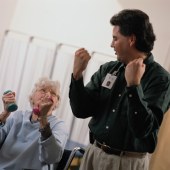Stroke Patients at High Risk for Falls
After hospital, they're twice as likely to be injured, so prevention strategies are key.
|
E-mail this article
Subscribe to news
Printer friendly version
|

(SOURCE: American Heart Association, news release, May 15, 2008)
THURSDAY, May 15 (HealthDay News) -- Stroke patients have a high risk of falling after they leave the hospital, a New Zealand study shows.
The University of Auckland researchers added that prevention programs may help lower that risk.
"People who have had a stroke fall almost twice as often as people who haven't had a stroke. Falls are very common, and risk factors for falls are easy to identify. We need to emphasize fall prevention during stroke services when patients resettle at home," lead author Ngaire Kerse, an associate professor in the department of general practice and primary health care at the School of Population Health, said in a prepared statement.
Kerse and colleagues found that 37 percent of 1,104 stroke survivors reported at least one fall during the first six months after their stroke. Of the 407 who fell, 37 percent suffered an injury that required medical treatment, and 8 percent suffered a fracture.
Among those who fell, about half fell only once, but 12 percent fell more than five times. The study also found that 77 percent of the patients fell at home and of the 93 patients who fell away from home, 42 fell indoors.
"This is much higher than reported previously. The incidence of falls in the study is even higher than for older people in long-term residential care," Kerse said.
Among the other findings:
- Older age, a prior fall, previous stroke, prior dependency before stroke, poor cognitive status and low mood such as depression were associated with either a higher risk of falls or injury after stroke.
- Women were more likely than men to suffer an injury due to falling.
- People who fell in the year prior to stroke were 1.6 times more likely to fall after a stroke.
- Patients with higher levels of functioning were 80 percent less likely to suffer an injury after stroke.
- Patients who were more dependent were twice as likely to fall after a stroke.
- Those who were depressed were almost 1.5 times more likely to fall than those who weren't depressed.
The study was published in the May 16 issue of Stroke.
"Falls are important for all older people. But in people with stroke, falls add to the consequences of stroke. There is an opportunity to offer fall prevention strategies as part of the initial rehabilitation for stroke patients and as part of ongoing rehabilitation in the home," Kerse said.
Fall prevention strategies should include:
- Lower leg strengthening, balance retraining and exercise programs.
- Assessment of fall hazards in the home and improvements such as appropriate lighting, removal of obstacles and installation of hand rails.
- Increased awareness of fall prevention among family members.
More information
The American Heart Association has more about the effects of stroke. 
Copyright © 2008 ScoutNews, LLC. All rights reserved. 
HealthDayNews articles are derived from various sources and do not reflect federal policy. healthfinder.gov does not endorse opinions, products, or services that may appear in news stories. For more information on health topics in the news, visit the healthfinder.gov health library.